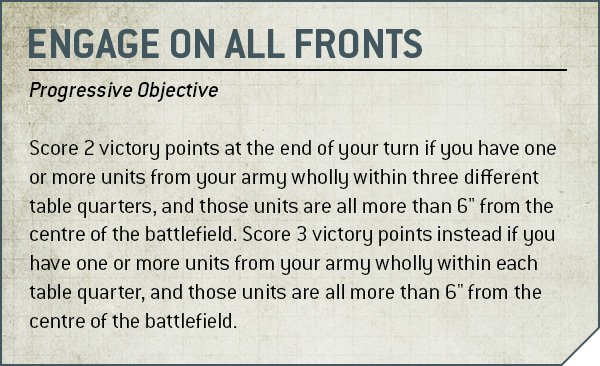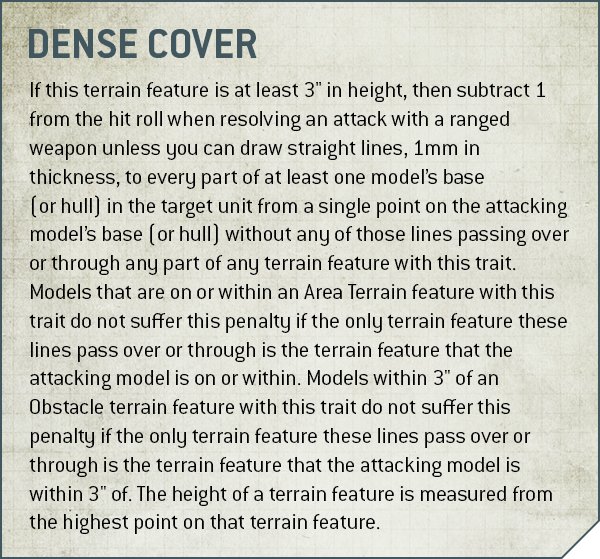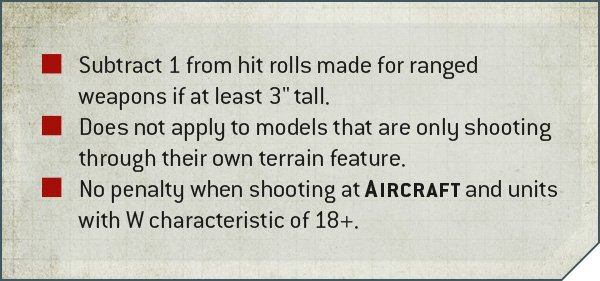9th edition is coming, with Warhammer 40k set to be transformed. Games Workshop have been posting details of the new edition every day, with Twitch streams and Warhammer Community articles giving us a tantalizing look into the new edition.
As anyone paying attention is aware by now, Warhammer Community has been running a full slate of 9th edition preview articles ever since the announcement stream finally let us know that it was coming. We’ve already written up some of these reveals where they were particularly chunky, but we’ve added them in again below for completeness. As with last week, a lot of the reveals have come through Faction Focus articles – the faction focuses themselves don’t really say much, but they seem to be the weapon of choice for leaking out core rules, so they’re worth reading for that alone.
If you missed our previous round-ups, click here for week 1, week 2, and week 3 respectively.
This week’s Faction Focuses:
Drukhari
T’au Empire
Astra Militarum
Tyranids
Craftworlds
So what have we learned about this week?
The Drukhari faction focus included a look at clarified rules for AIRCRAFT – most of this is similar to the position that we eventually arrived at with the 8th edition FAQs, but we get some clarification that AIRCRAFT never need to Fall Back – they just move away normally, and equally units engaging them can just leave again. This is important because of what we learned in the T’au faction focus… units which can FLY are no longer able to Fall Back and shoot! This is a huge change, affecting dozens of units. FLY was one of the most powerful keywords in 8th edition and a big part of that was the freedom to exploit Falling Back and shooting, and that is just gone.
Another thing we learned from T’au was also related to Fall Back moves, though a little differently:
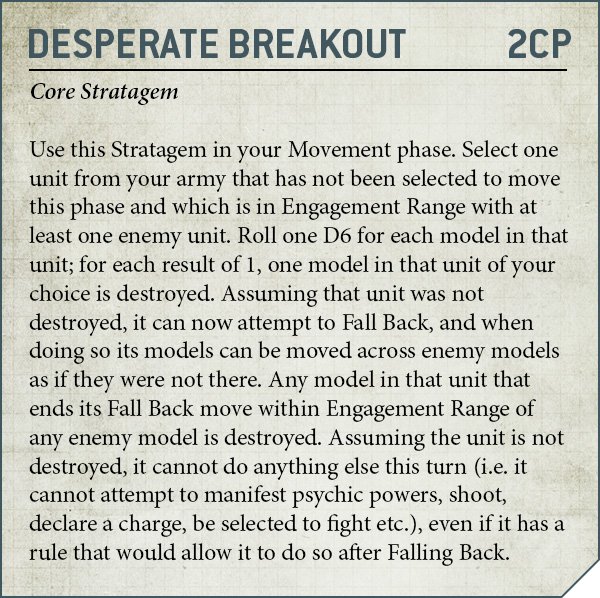 Desperate Breakout is an anti-wrapping stratagem, designed to remove the ability to trap a unit – particularly by way of tri-pointing. It’s still possible to wrap a unit and prevent it falling back, whether by more enterprising wrapping or by wrapping multiple units so that only one can utilise the Desperate Breakout stratagem, but it’s no longer as easy as simply taking a single model hostage.
Desperate Breakout is an anti-wrapping stratagem, designed to remove the ability to trap a unit – particularly by way of tri-pointing. It’s still possible to wrap a unit and prevent it falling back, whether by more enterprising wrapping or by wrapping multiple units so that only one can utilise the Desperate Breakout stratagem, but it’s no longer as easy as simply taking a single model hostage.
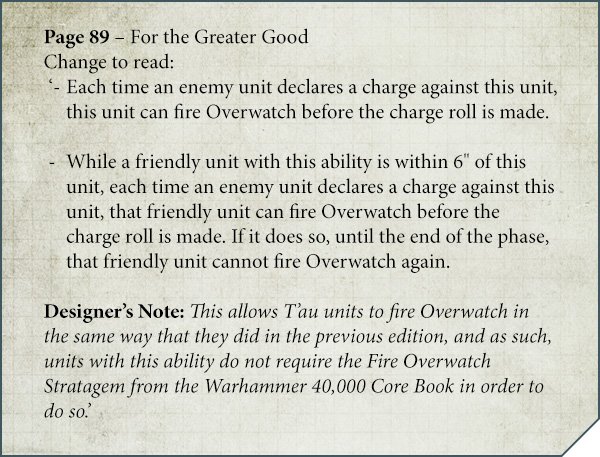 We also learned that T’au get to keep Overwatch as it works in 8th, and even keep For The Greater Good, so that’s just fabulous. Thanks a bunch, GW, this is definitely what everyone wanted.
We also learned that T’au get to keep Overwatch as it works in 8th, and even keep For The Greater Good, so that’s just fabulous. Thanks a bunch, GW, this is definitely what everyone wanted.
 We also got a full look at the limitation on modifiers, and the “6s always hit” rule that was mentioned on stream before.
We also got a full look at the limitation on modifiers, and the “6s always hit” rule that was mentioned on stream before.
T’au was quite a packed faction focus overall, unlike Craftworlds, which just gave us a context-free look at the secondary objective Engage on All Fronts:
Basically it’s Recon, but in pog form.
Luckily there was meatier stuff in both Astra Militarum and Tyranids. The Guard article focused on the new Morale phase, exploring the new mechanic of “combat attrition”:
There’s lots to unpack here. Morale is now a straight pass/fail – only one model flees regardless of how much you fail by, and also you can always pass on a 1 now. The old “lose as many models as you fail the test by” from 8th is now replaced with Combat Attrition as described above, where failing Morale means every model can potentially flee on the roll of a 1 – or on a 2 if the unit is below half strength. That’s a huge change. In the middle ground it should mostly be similar to before, but at the very top end of huge units failing Morale by a long way it means they’re not as likely to simply flee entirely – no more killing 20/30 Plaguebearers and letting Morale do the rest, for example. Equally at the bottom end, MSU armies of e.g. 5 model units with Ld8 basically didn’t interact with Morale. Now it’s that little bit more threatening for them, because if they have to test at all there’s a reasonable chance of them completely dying if they fail.
This also opens up some design space – a lot of abilities previously were based around manipulating Morale, and then being completely stonewalled by the existence of other abilities which gave immunity to it. Now there’s another element in play, and rules like Synapse could function as something like “halve the number of casualties from Combat Attrition” instead of simply removing Morale from the equation at all. It’s interesting to see what, if anything, gets explored here.
Tyranids had possibly the most controversial preview of the set, looking at the new Dense Cover terrain rules:
What do these mean? Well, the bullet points help clarify it – simply put, if you’re shooting at a unit in Dense Cover with a feature at least 3″ tall, you’re at -1 to hit for doing so. On the face of the rule it seems like you can shoot over Dense Terrain and still incur the -1 to hit penalty, though it’s not clear if that’s intended – a bit like how right now a unit inside of Obscuring terrain cannot shoot out of it (seriously look it up). The controversy here was less with the existence of the rule – it’s fine and hopefully helps distinguish things like e.g. woods or jungle terrain, which I would guess are the intended recipients – but with the language, which is not perhaps as readable as it could be. The bullet points help to bring clarity and hopefully the full book text expands on the point about whether Dense Terrain is meant to only apply to units inside of it or not.
That’s everything that came out of the Faction Focuses, but what else did we learn this week?
The two areas which got their own discussion were Strategic Reserves and Combat Patrol. We wrote about these at time of release, which you can find here (reserves) and here (Combat Patrol).
In brief, Strategic Reserves is a new option, a kind of halfway house between the old style familiar to many players from 5th-7th editions where you could reserve any unit you felt like, and the 8th ed version where you were unable to reserve units without a special rule or Stratagem allowing them to do so. Now any unit can be reserved, but it costs CP to do so, on a sliding scale based on (ugh) Power Rating – 1 CP for units up to a combined rating of 9, 2 CP for 10-19, 3 CP for 20-29, etc. This leads to an interesting tension between wanting to reserve units to keep them safe, but having to sacrifice CP to do so, and some quite hard cut-offs – if you want to reserve two units of 5 power each, it’s a big jump in cost compared to just one. Like a lot of other 9th edition rules, it’s a bit context-free at the moment – we don’t know if you can reserve your entire army and null-deploy, and we don’t know how the article’s mention of being able to leap into combat on your own board edge will work in terms of large units possibly daisy-chaining across the new smaller tables. Not being able to protect key units was a bugbear of 8th, and it’s nice to see it’s more broadly accessible now. Don’t fear if your faction has these abilities already built in, though – obviously units which had deep-strike equivalent abilities retain those as great free options, and there’s also benefit to e.g. Webway Assault or Strike from the Shadows, since those stratagems are agnostic on PL.
Combat Patrol is the new smaller game size, for 500pt games on smaller boards. Initially it looks much more thoughtful than previous iterations of the same thing, and we’re hopeful it makes small-points games a lot more viable than they have been – though of course you never know, and there’s some initial qualms like the mentions of Knights being in play at that size.
That’s it for this week’s 9th edition reveals – we’re very excited to finally see the release, and we’re hoping that we don’t have too much longer to wait!


